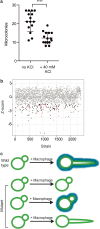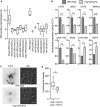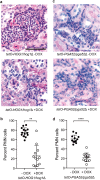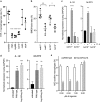High-Throughput Screening Identifies Genes Required for Candida albicans Induction of Macrophage Pyroptosis
- PMID: 30131363
- PMCID: PMC6106084
- DOI: 10.1128/mBio.01581-18
High-Throughput Screening Identifies Genes Required for Candida albicans Induction of Macrophage Pyroptosis
Abstract
The innate immune system is the first line of defense against invasive fungal infections. As a consequence, many successful fungal pathogens have evolved elegant strategies to interact with host immune cells. For example, Candida albicans undergoes a morphogenetic switch coupled to cell wall remodeling upon phagocytosis by macrophages and then induces macrophage pyroptosis, an inflammatory cell death program. To elucidate the genetic circuitry through which C. albicans orchestrates this host response, we performed the first large-scale analysis of C. albicans interactions with mammalian immune cells. We identified 98 C. albicans genes that enable macrophage pyroptosis without influencing fungal cell morphology in the macrophage, including specific determinants of cell wall biogenesis and the Hog1 signaling cascade. Using these mutated genes, we discovered that defects in the activation of pyroptosis affect immune cell recruitment during infection. Examining host circuitry required for pyroptosis in response to C. albicans infection, we discovered that inflammasome priming and activation can be decoupled. Finally, we observed that
Keywords: Candida; cell wall remodelling; functional genomics; fungal morphogenesis; fungal pathogenesis; host-pathogen interaction; pyroptosis.
Copyright © 2018 O’Meara et al.
Figures







Comment in
-
Insights into the host-pathogen interaction: C. albicans manipulation of macrophage pyroptosis.Microb Cell. 2018 Nov 12;5(12):566-568. doi: 10.15698/mic2018.12.662. Microb Cell. 2018. PMID: 30533421 Free PMC article.
Similar articles
-
The pathogen Candida albicans hijacks pyroptosis for escape from macrophages.mBio. 2014 Mar 25;5(2):e00003-14. doi: 10.1128/mBio.00003-14. mBio. 2014. PMID: 24667705 Free PMC article.
-
Insights into the host-pathogen interaction: C. albicans manipulation of macrophage pyroptosis.Microb Cell. 2018 Nov 12;5(12):566-568. doi: 10.15698/mic2018.12.662. Microb Cell. 2018. PMID: 30533421 Free PMC article.
-
A Genome-Wide Screen of Deletion Mutants in the Filamentous Saccharomyces cerevisiae Background Identifies Ergosterol as a Direct Trigger of Macrophage Pyroptosis.mBio. 2018 Jul 31;9(4):e01204-18. doi: 10.1128/mBio.01204-18. mBio. 2018. PMID: 30065091 Free PMC article.
-
Macrophage pyroptosis induced by Candida albicans.Pathog Dis. 2024 Feb 7;82:ftae003. doi: 10.1093/femspd/ftae003. Pathog Dis. 2024. PMID: 38499444 Free PMC article. Review.
-
The Dual Function of the Fungal Toxin Candidalysin during Candida albicans-Macrophage Interaction and Virulence.Toxins (Basel). 2020 Jul 24;12(8):469. doi: 10.3390/toxins12080469. Toxins (Basel). 2020. PMID: 32722029 Free PMC article. Review.
Cited by
-
Magnesium impairs Candida albicans immune evasion by reduced hyphal damage, enhanced β-glucan exposure and altered vacuole homeostasis.PLoS One. 2022 Jul 14;17(7):e0270676. doi: 10.1371/journal.pone.0270676. eCollection 2022. PLoS One. 2022. PMID: 35834579 Free PMC article.
-
Global proteomic analyses define an environmentally contingent Hsp90 interactome and reveal chaperone-dependent regulation of stress granule proteins and the R2TP complex in a fungal pathogen.PLoS Biol. 2019 Jul 8;17(7):e3000358. doi: 10.1371/journal.pbio.3000358. eCollection 2019 Jul. PLoS Biol. 2019. PMID: 31283755 Free PMC article.
-
Nucleotide Excision Repair Protein Rad23 Regulates Cell Virulence Independent of Rad4 in Candida albicans.mSphere. 2020 Feb 19;5(1):e00062-20. doi: 10.1128/mSphere.00062-20. mSphere. 2020. PMID: 32075883 Free PMC article.
-
Construction of Candida albicans Strains with ATP-Analog-Sensitive Protein Kinase A and Hog1.mSphere. 2023 Jun 22;8(3):e0009523. doi: 10.1128/msphere.00095-23. Epub 2023 Apr 11. mSphere. 2023. PMID: 37039635 Free PMC article.
-
The Interactions Between Candida albicans and Mucosal Immunity.Front Microbiol. 2021 Jun 21;12:652725. doi: 10.3389/fmicb.2021.652725. eCollection 2021. Front Microbiol. 2021. PMID: 34234752 Free PMC article. Review.
References
Publication types
MeSH terms
Grants and funding
LinkOut - more resources
Full Text Sources
Other Literature Sources
Research Materials
Miscellaneous

